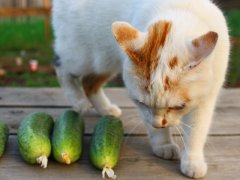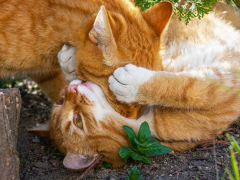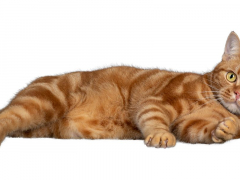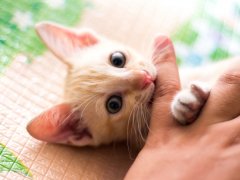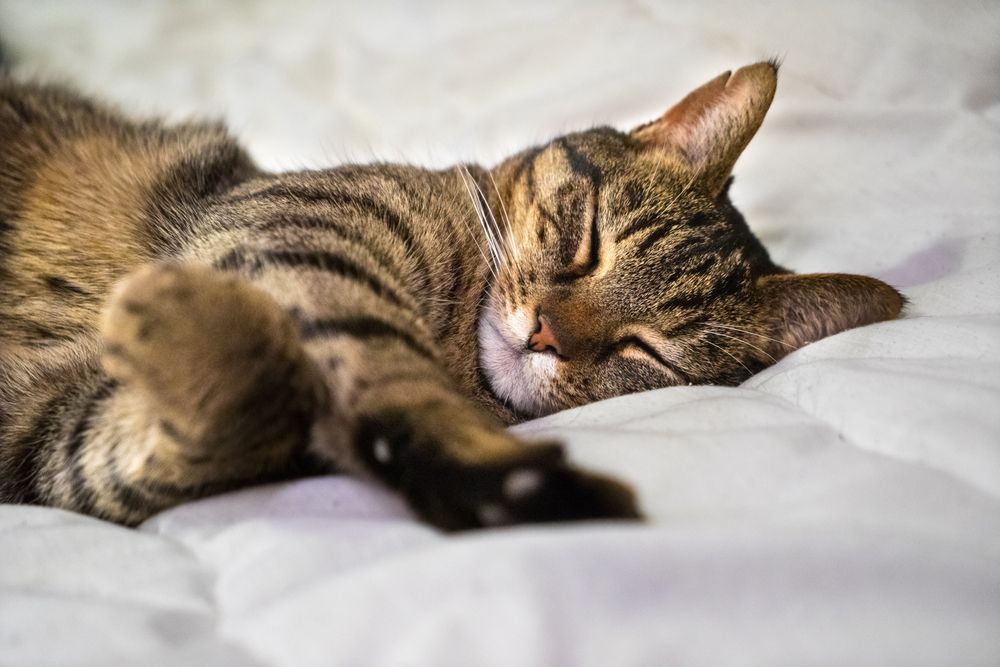
Cats are absolute sweethearts when they are asleep, even the most mischievous kitties appear like snugly angels when they’re all curled up on the couch or snoozing in the sun.
Felines are able to sleep nearly everywhere including in any position, however how and where they snooze isn’t random as it may seem.
A cat’s sleeping posture, pattern and location can reveal a lot about your cat’s temperament, health and how they’re feeling so let’s examine common sleeping positions, they’re connotation and discover if your cat is relaxed, tense or may be in pain.
Do Resting And Sleeping Positions Matter?

If you have a cat, you know they spend most of their time resting or sleeping. A cat that’s resting is inactive and stationery. They may be sitting or lying down, their position may differ, and their resting stance will exhibit either a relaxed or a tense state however their posture won’t indicate an underlying emotional state.
Whereas when a cat is sleeping their eyes will be closed and muscles completely relaxed although twitching may be seen on occasion which may relate to REM sleep (ICatCare, 2010).
Common Cat Sleeping Positions And The Meaning Behind Them
Napping moggies demonstrate many poses, usually a cat’s snoozing posture can be indicative of your cat’s mood and underlying health, although a sleeping posture alone won’t postulate whether your feline is unwell, the way a cat rests or their sleep pattern, site and stance may provide an indication of their welfare status in conjunction with other behavioural and clinical signs.
1. Curled Up
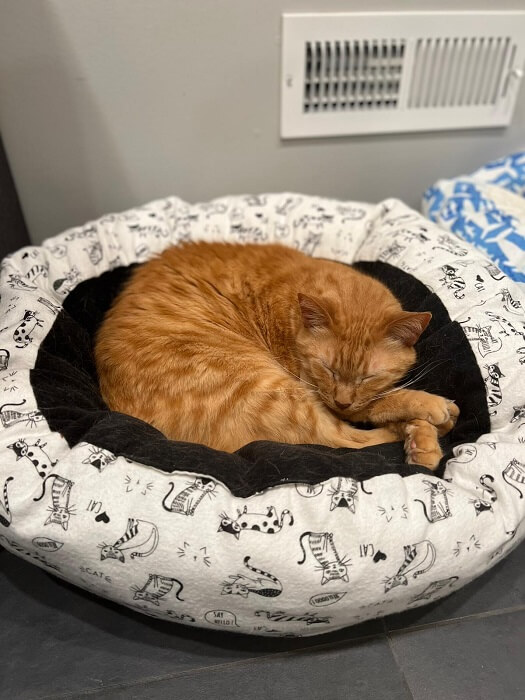
Soldier curled up. Melina Grin / Cats.com
This is the most widespread, natural sleeping posture a cat will display. Most cats are likely to curl up into a small circle for a peaceful catnap when sleeping or resting. When asleep their head is rested flat against the surface on which the cat is lying, furthermore this posture keeps their body warm and protects vital organs.
2. Belly Up
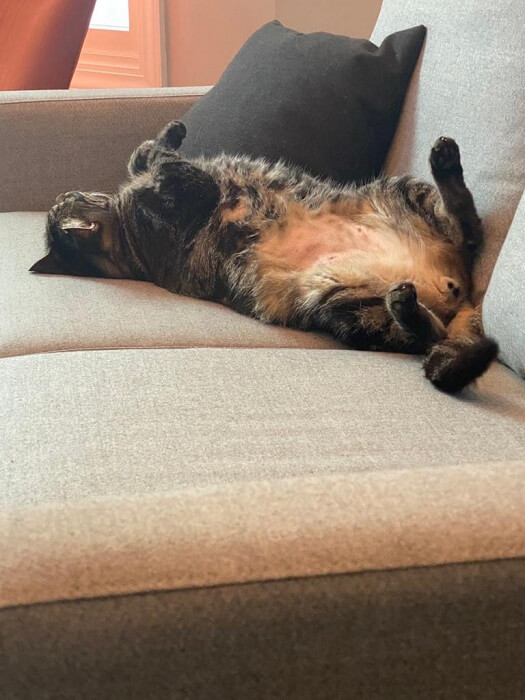
Menny Belly up. Melina Grin / Cats.com
Sleeping on the back with the belly exposed indicates total relaxation and wellbeing. The cat’s stomach is the most vulnerable part of their body, lying flat on the back with the legs extended in the air unable to quickly escape in case of danger exhibits total trust. Please avoid touching your cat’s belly while its napping in this position, no matter how tempting it is!
3. Sideways
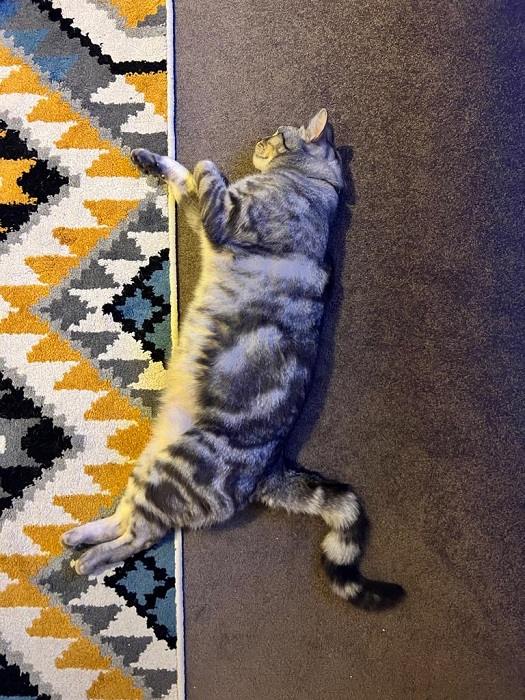
Jose Miguel sleeping sideways. Melina Grin / Cats.com
A sideways sleeping posture indicates your cat is relaxed however not always in deep sleep mode. Their belly is exposed, and their limbs are protracted out nevertheless your kitty is content but alert.
4. The Acrobat / Contortionist
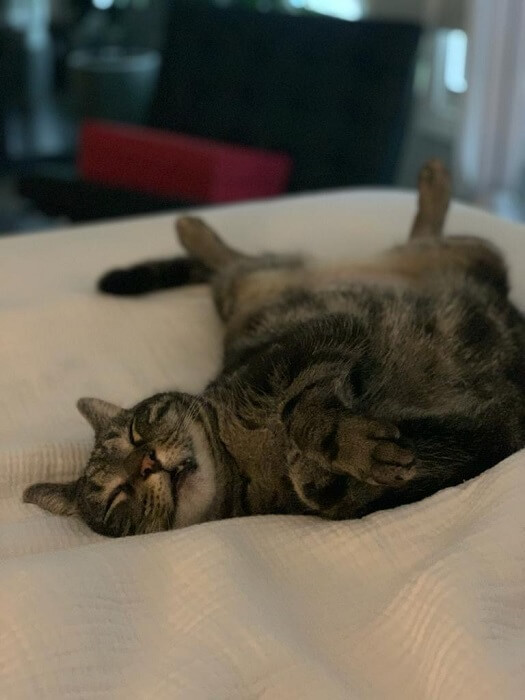
Menny the Acrobat. Melina Grin / Cats.com
This is the weirdest sleeping pose your cat will exhibit with their body appearing to twist with limbs warping in all directions while the head twists in an uncomfortable angel. The science behind this posture hasn’t been researched as yet, however if your cat is comfortable and relaxed, enjoy the moment and watch them from the far.
5. Paw Across The Face
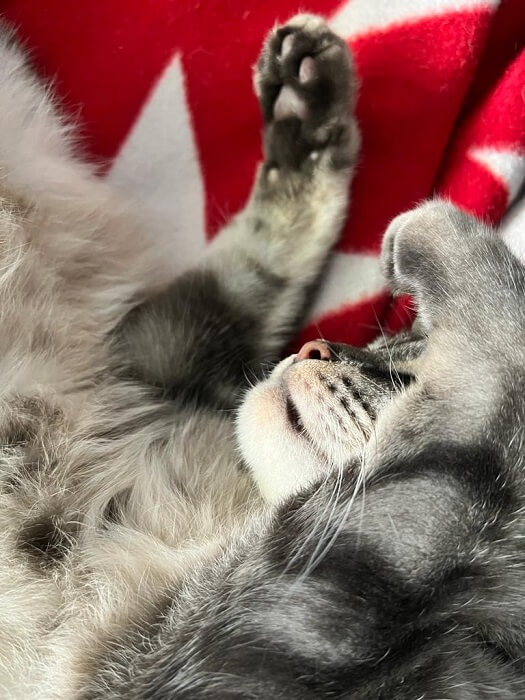
Jose Miguel sleeping with paw across his face. Melina Grin / Cats.com
This is my favourite and most adorable posture which commonly occurs when your cat places it’s paw across their face, most likely to let you know they don’t wish to be disturbed or when they want to block out bright daylight.
6. Tucked In
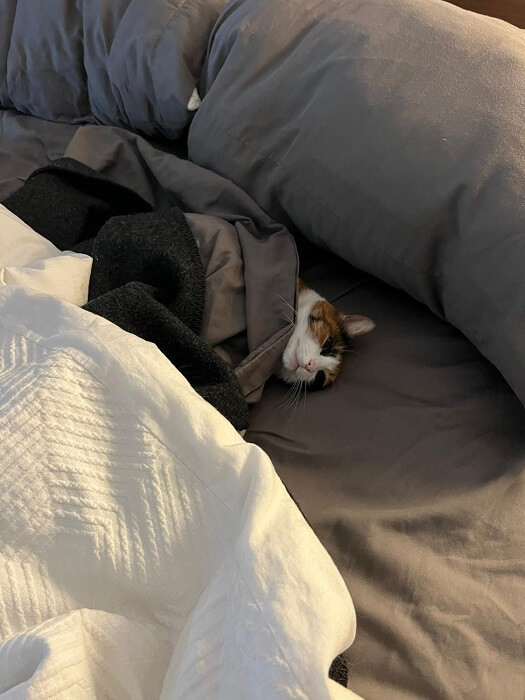
Biz tucked in bed. Melina Grin / Cats.com
Not all cats like being under the covers or tucked in, some crawl under the covers with their noses poking out at a small crack for oxygen, most of these cats seek it out as a form of security plus comfort with the assurance of a quiet place to sleep and protection from invaders. Another reason your cat may sneak under the blanket is to conserve body heat and seek warmth.
7. On Top Of You
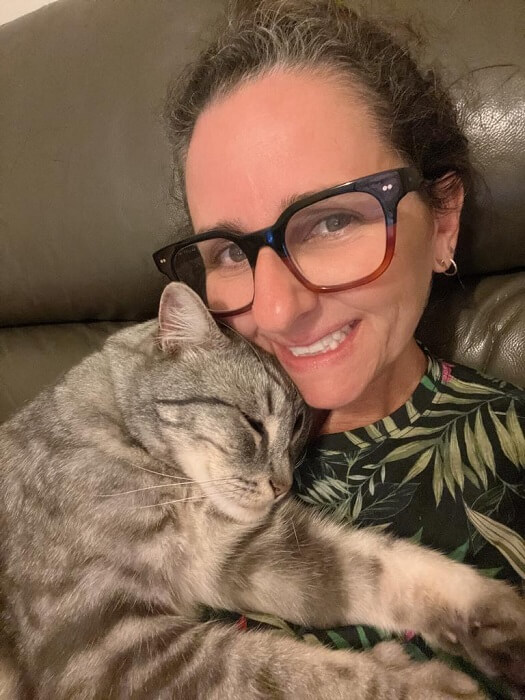
Jose Miguel sleeping on top of his owner Alexandra. Melina Grin / Cats.com
When a cat chooses to sleep on top of you take it as a compliment. The relationship you have with your individual cat is unique in nature, many cats display their affection through grooming and napping on top of their owners, there’s also the extra added bonus of warmth for the cat in the cooler months. Your cat is feeling secure and at ease increasing the human-animal bond.
8.Social Group Naps
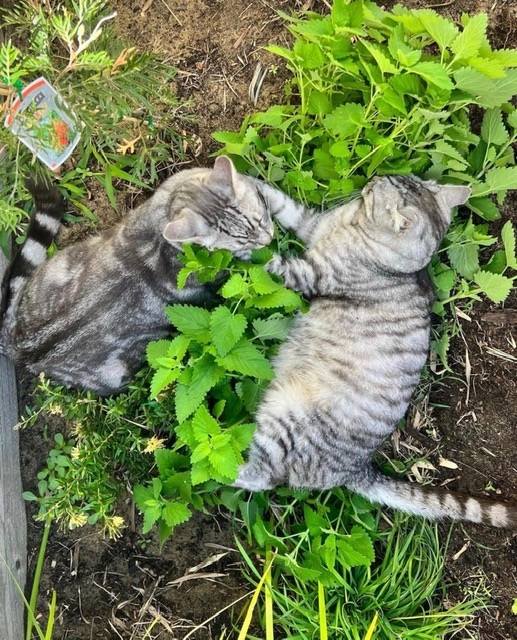
Jose Miguel and Jimmy sleeping on top of Catnip plant. Melina Grin / Cats.com
Cats that are part of the same social group (who display affiliative behaviours) may select to sleep in close contact with each other. The same may occur if your cat has a close friendship with your dog, they might also prefer to sleep in closeness, nevertheless both your cat(s) and dog should have separate pet-beds.
Cat Sleeping Positions When Sick Or In Pain
A stressed or painful feline may struggle to rest, snooze more or slumber in an unusual pose, presumably since movement is painful which suggests a negative emotional state of the cat.
Let’s look at few resting and sleeping stances cat’s exhibit once they are sick or in pain:
Hunched Posture With Head Tilt Down
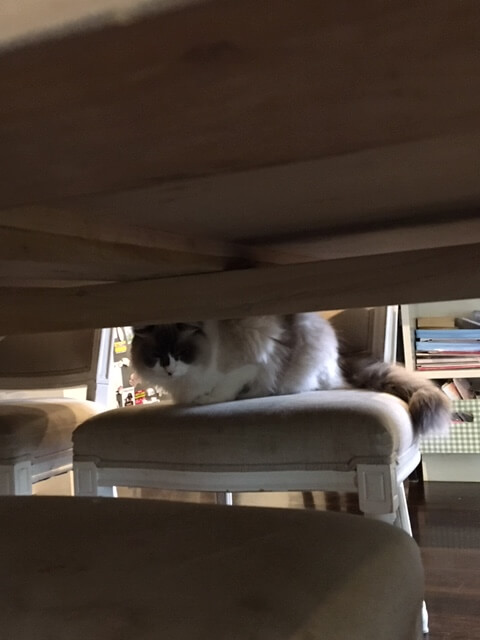
Unwell Daisy hunched with head tilt down due to gastrointestional problem trying to sleep on the chair. Melina Grin / Cats.com
Similarly to people who feel unwell, a sick cat could also be tense, adopt a hunched body posture with their head tilted down, their ears may also be rotated outward, whiskers may be straight or away from their face, their coat can seem dull or perhaps matted due to under-grooming.
A hunched sleeping stance is most frequently seen in felines with Chronic Kidney Disease, those suffering from Osteoarthritis, Feline Distemper, Pancreatitis, Cancer and Gastrointestinal problems.
Head And Neck Protraction
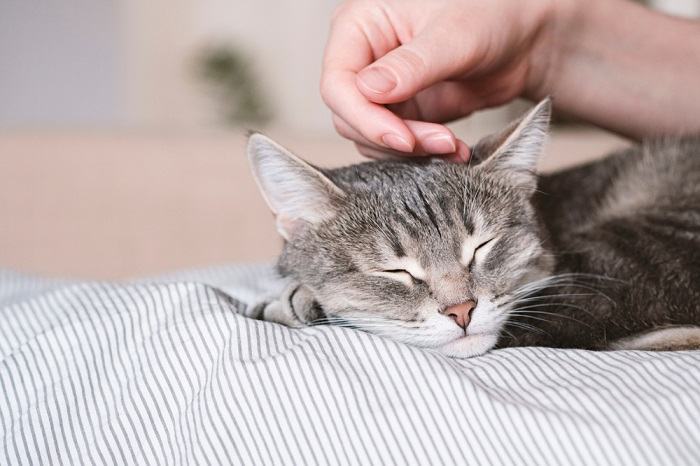
A cat who sleeps with their head and neck protracted out who also exhibits either sneezing, coughing or breathing difficulties may be experiencing respiratory issues or heart conditions making it difficult to sleep in a normal posture all requiring an immediate veterinary examination.
Cat Sleeping Positions Chart
The following illustrates common position’s felines adopt while sleeping and their significance:
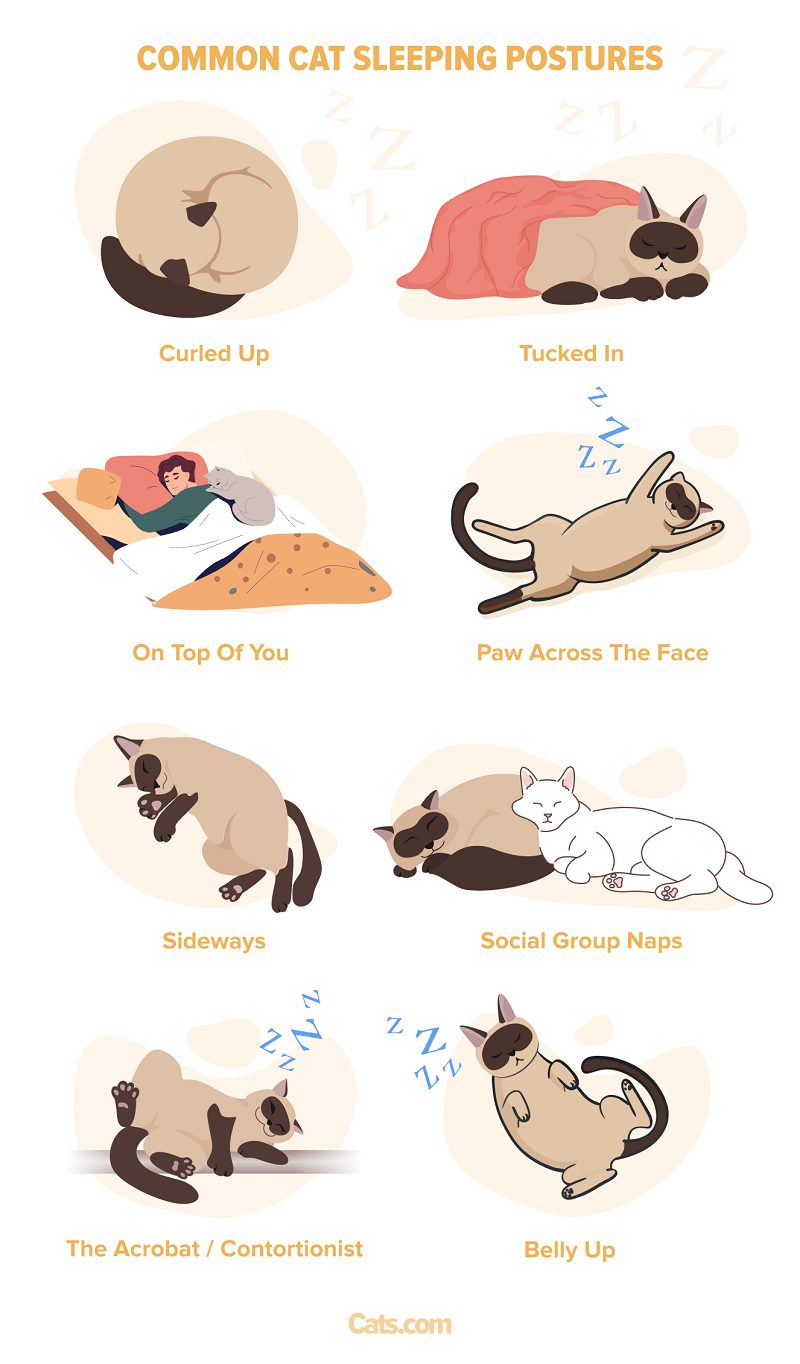
Sleeping In Abnormal Spots Or Changes In Sleeping Positions

Snowball is ill post ingestion of almons, trying to find a comfortable sleeping stance. Melina Grin / Cats.com
If your cat suddenly starts sleeping in abnormal spaces or exhibits changes in their sleeping postures and patterns (sleeping constantly or feign sleep), it may be indicative they’re struggling to find a comfortable resting stance as well as they’re in pain.
Watch for other clinical signs like a tense body posture, eye squinting, shifts in facial expressions, decreased appetite and increased vocalizations, all warranting a vet exam.
General Cat Sleeping Habits
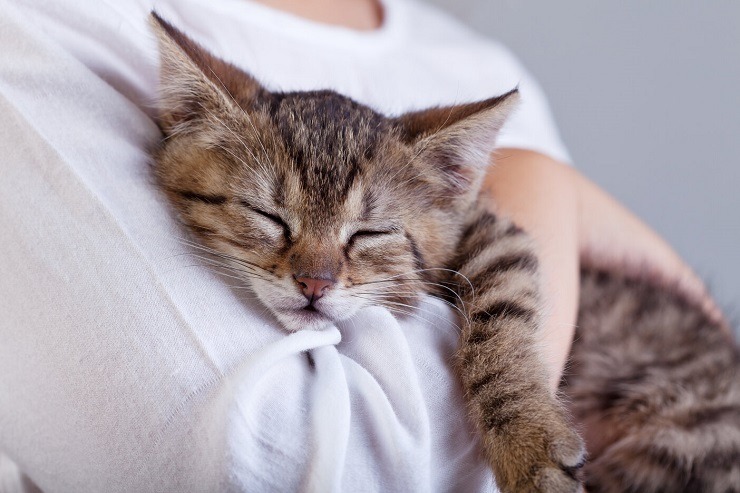
Cats sleep frequently during the day. On average, a cat will spend 2.8 hours resting and 7.8 hours throughout the day napping. Indoor-only cats kip more than cats with access to the outdoors.
Also Read: 8 Most Common Cat Sleeping Positions and What They Really Mean
Sleeping Within Confined Spaces
Felines select a variety of resting and sleeping spots based on their temperament, mood and health condition, unlike dogs, they don’t usually sleep on the ground, even when offered comfortable beds.
Both when resting or sleeping, moggies select a posture where they’re on a raised-up surface, covered or within a confined space like a box, in a pet bed, against a cushion or if outdoors amongst bushes.
Anxious or skittish cats prefer to hide or conceal themselves in small dark confined spots (wardrobes or under bedding), while confident cats like to shelter themselves for uninterrupted sleep-in boxes, tunnels plus bags while kitties with joint disease prefer warm, easily accessible cat-beds.
Lastly, kitties are more likely to rest in distinct areas to sleeping holes, additionally they like to snooze alone hence it’s important to offer your kitty comfortable, secure spaces for rest and sleep in each area of the house and garden they frequent.
Crepuscular Hunters
Cats are both prey and predator, active around dawn and dusk with natural-born hunting instincts, hence they need lots of rest and sleep in between hunting sessions.
Weather
Your cat’s sleeping habits will be altered during winter, on hot and rainy days, with most cats asleep for longer durations.
Senior And Geriatric Cats
As cats get older, often as a result of physiological alterations, their behaviour changes. Elderly and geriatric cats become more vocal, less active, they eat and hunt less as well as spend more time sleeping (even when outdoors). Some geriatric cats also develop cognitive dysfunction with altered sleep patterns all requiring veterinary intervention.
Conclusion
There aren’t lots of sleep related research in cats, however sleep is an important behaviour that can signify a cat’s adaptation to the surroundings including their welfare.
A variation in your cat’s sleep pattern, changes in sleeping posture or insomnia can indicate stress or illness thus please consult your veterinarian to ensure early detection with appropriate options for treatment are provided.
-
Atkinson, T. (2018). Practical Feline Behaviour. Wallingford, Oxfordshire, UK: CABI. Retrieved February 08, 2022
-
Fraser, A. F. (2012). Feline Behaviour and Welfare. (S. Hulbert, Ed.) CAB International. Retrieved February 14, 2022
-
Heath, I. R. (2016). Feline Behavioral Health and Welfare. St Louis, MO: Elsevier. Retrieved February 06, 2022
-
ICatCare, U. a. (2010). Cat Behaviour Described Chapter 1 Maintenance Behaviour. (U. o. Lincoln, Compiler) UK. Retrieved February 02, 2020
-
Sparkes, D. S. (2016). ISFM Guide to Feline Stress and Health; Managing negative emotions to improve feline health and wellbeing. Tisbury, Wiltshire, UK: International Cat Care. Retrieved February 10, 2022
